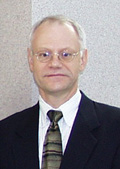A UNMC physician will coordinate the University of Nebraska’s bioterrorism preparedness efforts.
 Steven Hinrichs, M.D., director of the Nebraska Public Health Laboratory (NPHL), was named to his new role Tuesday by NU President L. Dennis Smith, Ph.D. Dr. Smith also released a bioterrorism preparedness report that was prepared by a task force chaired by UNMC Chancellor Harold M. Maurer, M.D. (Read the full report).
Steven Hinrichs, M.D., director of the Nebraska Public Health Laboratory (NPHL), was named to his new role Tuesday by NU President L. Dennis Smith, Ph.D. Dr. Smith also released a bioterrorism preparedness report that was prepared by a task force chaired by UNMC Chancellor Harold M. Maurer, M.D. (Read the full report).
“I look forward to working with my university colleagues and state government leaders to maximize the bioterrorism preparedness on our campuses and throughout the state,” said Dr. Hinrichs, an associate professor of pathology/microbiology at UNMC. “Certainly, one of our initial focuses will be to ensure the safety and security of the students and faculty on each of the university’s campuses.”
President Smith said the bioterrorism preparedness report makes it clear that the university is well-prepared for potential incidents directly affecting the university’s four campuses.
“We also are well-equipped to be a leader in several key areas of bioterrorism preparedness, including education, research, information technology and communications,” Dr. Smith said.
The task force, Dr. Maurer said, analyzed how the university can improve in those areas and others to strengthen its own bioterrorism preparedness, as well as the state’s.
“Our task force looked at how the university can become a national leader in bioterrorism preparedness, as well as fulfill our mission to the state as a resource in education, research and assistance to other agencies,” Dr. Maurer said. “We also looked at how we can become a model employer, as far as the education and preparedness of our own employees.”
The task force’s report says the university has experience and expertise in many bioterrorism-related areas. These areas include the isolation and identification of microbial agents and the treatment of people exposed to such agents; the teaching of many courses and the conduct of training programs related to bioterrorism; and serving as a valuable scientific resource to state and federal governments. Already, the NPHL, housed at UNMC, has served as a valuable resource in recent real and suspected incidents of anthrax contamination. The university also has expertise that could be tapped in agriculture and information technology.
The report also notes some gaps in the university’s processes to protect against bioterrorism and to control biological agents. While the university complies with all federal and state regulations regarding such agents – and nuclear and chemical agents are well-catalogued and secure – systems for housing, controlling and disposal of biological agents should be tighter and more consistent across all four university campuses, the report says. Record-keeping and logs of personnel who use biological agents also should be more thorough and consistent.
The report made the following recommendations:
- Develop and implement detailed, up-to-date system-wide and campus-specific safety and security guidelines.
- Develop educational programs on bioterrorism for students, employees, business leaders and the public.
- Use the university’s information technology expertise to help establish Nebraska as a leader in electronic communications and bioterrorism surveillance.
- Provide a single contact for the university’s clinical medicine expertise and services related to bioterrorism, and increase accessibility to these services by state government, businesses and the public.
- Expand and further develop coordinated bioterrorism-related research.
- Appoint Dr. Steven Hinrichs, reporting directly to the university president, to provide continuing leadership in bioterrorism preparedness.
Adoption of the recommendations, the report says, would position the University of Nebraska to develop a nationally recognized bioterrorism center, serve as a model employer regarding preparedness and training, serve as a resource for other colleges and universities, and collaborate with government and private-sector groups to coordinate bioterrorism preparedness.
President Smith thanked the 31-member task force that produced the report.
“This report is comprehensive, and provides a good assessment of where the university is now – and where we need to go – in our bioterrorism preparedness efforts,” Dr. Smith said.